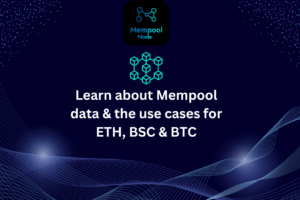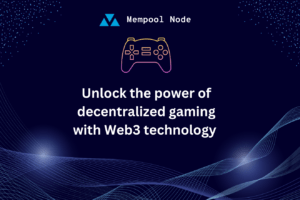How Polygon Web3 Developers & Traders Use Mempool Data
The Ethereum ecosystem is constantly growing and changing, and staying informed is crucial for Web3 developers and traders. One of the hottest areas in the industry right now is the Polygon network. Polygon has gained popularity among Web3 developers who build decentralized applications (dApps) and traders searching for DEX opportunities. The number of people utilizing Polygon has increased significantly. But there’s one aspect of the Polygon network that every developer should know about: the mempool.
In this article, we explore the Polygon mempool. We explain its definition, operation, and significance. As well as why monitoring it is crucial for anyone building, trading, or deploying dApps on the Polygon network.
What is the Polygon Mempool?
The Polygon network’s mempool holds all transactions pending validation. Once a user initiates a transaction, it enters the mempool and awaits validation. Picture a queue where transactions await processing. The mempool’s size fluctuates with the broadcasted transactions to the network. Transactions enter the mempool and patiently wait their turn to be added to the next block.
How Does the Polygon Mempool Work?
The Polygon mempool operates with a priority-based system, where transactions with higher fees get priority over lower-fee transactions. Adding a higher fee to your transaction increases the chances of it being processed quickly. This incentivizes users to include a larger fee and discourages spamming the network with low-fee transactions, ensuring a smooth and efficient processing of legitimate transactions.
Why is Monitoring the Polygon Mempool Important for Web3 Developers?
For developers, keeping an eye on the Polygon mempool is crucial. Understanding the health and activity of the network through the mempool size can lead to smoother dApp performance. A congested mempool may slow down transaction processing, so it’s important to monitor it regularly. Developers can use tools such as Mempool Node’s Webhook API to stay informed about the current state of the network and adjust their transaction fees accordingly. This ensures timely processing of their transactions, giving them a competitive advantage in the decentralized realm.
Maximising Mempool data for Trading and MEV Opportunities?
Traders and MEV searchers have a unique advantage when it comes to using mempool data. They gain real-time insights into imminent transactions by monitoring the Polygon mempool, enabling informed decisions and maintaining a competitive advantage.
The Polygon mempool offers traders a wealth of opportunities for arbitrage and front-running strategies. By using tools such as Mempool Node’s Polygon mempool monitoring webhook API alerts, traders can identify pending transactions that will significantly impact liquidity in a specific pool, and therefore, the exchange rate. This gives traders the power to submit their transactions before or after these pending transactions, taking advantage of the exchange rate difference. For instance, many traders keep a close eye on popular contracts like Quickswap’s factory, to stay informed of new trading pairs. By tracking mempool data, they can anticipate these developments and create new trading strategies.
Traditionally, such advanced trading strategies were only accessible to a limited demographic due to infrastructure and capital constraints. However, with the emergence of Ethereum scaling solutions like Polygon, advanced crypto trading strategies are now possible for a wider range of traders and MEV searchers. This expands the demographic of traders who can take advantage of these opportunities, making the world of crypto trading more accessible to everyone.
Start Now
-
Harness the Power of Polygon mempool data, Polygon is a thriving ecosystem that opens up a world of opportunities for Web3 developers and traders at a fraction of the cost of Ethereum’s mainnet. Mempool Node offers a one-stop solution for accessing reliable and actionable mempool data.
-
Streamline Your Operations with our Webhook API. Our webhook API provides lightning-fast processing of up to 5,000 pending transactions per second, real-time notifications, and unified monitoring across multiple blockchains. Stay ahead of the curve with accurate, real-time insights into in-flight transactions and easy-to-use tools for informed decision-making.
-
Elevate Your Business with Mempool Node, so you can run a top-notch infrastructure without the hassle of setting it up yourself. Our team is dedicated to creating user-friendly tools so you can focus on building and trading. Start unlocking the full potential of Polygon’s ecosystem today – try Mempool Node for free with custom configurations on the Mempool Node Dashboard and connect with others on Polygon.



